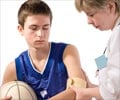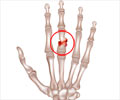Mutual communication and healthy dialogue between researchers, practitioners and sports community may prevent sports injuries

The common symptoms of sports injuries are localized swelling, redness, loss of function and heat generation.
The Public Health Model is a four stage model and aims at promoting the research in sports medicine in a stepwise manner and involves recognition of the problem and adoption of effective problem solving interventions.
Stage 1- Assessing the magnitude of the problem;
Stage 2- Recognizing the risk factors;
Stage 3- Development of effective interventions;
Dale Hanson and colleagues analyzed the role of research and active interventions in preventing sports injuries.
Though the researchers have gathered significant knowledge from surveillance, identification of risk factors and efficacy and effectiveness of the studies, yet this knowledge is to be adopted for bringing about a change and improvement in the field of sports medicines.
The lacunas responsible for preventing proper research and safety promotion are:
• The efficacy-to-effectiveness gap,
• The research-to-practice gap,
• The injury-prevention-to-safety-promotion gap.
These lacunas or gaps have emerged from contrasting approaches among policy-makers, researchers, practitioners, etc.
The efficacy-to-effectiveness gap-
This is a scientific problem. “The transition from researching what works (i.e., efficacy and effectiveness research) to how to make it work (i.e., implementation research) is a critical step, but not straightforward.”
The problem arises from the way researchers approach the problem in a complicated way.
It is important to understand that success is not entirely determined by the efficacy of intervention but is also affected by multiple inter-related factors.
Green has mentioned, ‘Where did the field get the idea that evidence of an intervention's efficacy from carefully controlled trials could be generalized as ‘best practice’ for widely varied populations and situations?’
Sports injuries are a complex problem and not a complicated problem. It requires a more scientific approach and health researchers are now adopting innovative techniques in dealing with them such as multilevel analysis, systems modeling, network analysis and agent-based modeling.
The research-to-practice gap-
This is an implementation problem. “The RE-AIM framework (Reach, Effectiveness, Adoption, Implementation and Maintenance)13 has recently been proposed as a reporting template to encourage sports researchers to document their research in a way that enables practitioners, policy makers and communities to use them effectively.”
About 27 articles from 11 leading health journals dealing with community-based interventions were reviewed and efficacy was observed in 100 percent and reach in 88 percent while implementation was noticed in 59 percent and behavioral in 33 percent articles. None of the articles reported institutional maintenance and the condition is no different for sports medicine.
The injury-prevention-to-safety-promotion gap-
This is a political problem. The widespread adoption of sports injury interventions is a social objective and is affected by political interests. Politicians are Public Policy makers and are in a position to make active and effective interventions for preventing sports injuries.
Closing the gap-
Mercy et al first proposed the Public Health Model for injury prevention and stated that a bottom-line approach is needed to bring practitioners, policy makers and the community to a common platform in order to bring a sustainable solution to the problem.
Some researcher advocated a top-down approach and expected to bring an effective intervention. It is important to keep in mind the importance of community after all it is the community that is ultimately affected.
“Sports researchers who ignore the community's perspective are destined to fail in the final critical dissemination and widespread adoption phase of the Public Health Model.”
The effectiveness of interventions can be established by three types of experts:
• Researchers (i.e., content experts),
• Clinicians, practitioners and policy makers (ie, process experts),
• Members of the target community, sports bodies (ie, context experts).
All three are essential partners in bringing about active and effective interventional alterations in sports injuries.
Good communication, excellent translation and good research are needed to have good dialogue and multidirectional conversation where other’s opinion is respected and valued. We should have the patience and humility to listen to practitioners, policy makers and sports community, the relevance and magnitude of our research can be enhanced. The research can become more practical and more applicable for the real world.
It can be concluded by saying that sports injuries are very much preventable. It is important to understand ‘how it can be prevented’ rather than ‘what can be done’. There should be mutual communication and healthy dialogue between researchers, practitioners and sports community. This combined cooperation will produce benefits for public health as well as sports medicines.
Reference:
Research alone is not sufficient to prevent sports injury; Dale Hanson et al; Br J Sports Med doi:10.1136/bjsports-2012-091434
Source-Medindia














